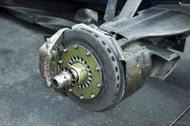How to Bleed Your Brakes Right
13th Jan 2016
Learn How to Bleed Your Brakes Correctly
Why Do I Have To Bleed My Brakes?
If you get a spongy, squishy feeling when you step on your brake after getting new brake pads, chances are you need to bleed the brakes. What does that mean? A seemingly scary process by name, bleeding the brakes means ridding the brake system of the trapped air. Sometimes, when the brake fluid level drops too low in the master cylinder reservoir, air bubbles will get caught in the line which causes the spongy feeling.
Manufacturers recommend replacing your brake fluid every two to three years or so as fluid deteriorates with use. In addition, brake fluid is hygroscopic, which means that it absorbs moisture from the air. This reduces the fluid’s heat resistance and can cause brake-system corrosion. Eventually, the clean and clear brake fluid will start to look more like clouded ink.
This is a moderately difficult DIY repair, if you have a very limited knowledge of automotive repairs, it may be best to leave this to a professional. The process does gets a bit easier with the help of a friend.
Click to jump to a section:
Choosing Brake Fluid & DOT Ratings
Tools for Bleeding Brakes:
|
|
|
|
|
|
|
|
Box-end Wrench |
Brake Fluid | Turkey Baster/Syringe |
Fluid Holder and Tubing |
1x4 Piece of Timber | Friend/Buddy |
For an all inclusive bleeding brakes tool kit, check out:
How to Bleed Your Brakes
|
|
Find the bleeder valves and make sure that you can loosen them. Use a box-end wrench that fits the size of the bleeder bolt, loosen the bolts but leave them closed. |
|
|
Locate the
master cylinder reservoir
—this is usually a light colored container with a dark lip that’s inline with your brake pedal in the engine department. Draw out the old oil fluids with a turkey baster or syringe. Be sure not to spill the fluid on any painted surface as it will remove paint! Clean the reservoir of any sediment with a clean rag. |
|
|
Get a piece of clear plastic tubing and push one end over the brake bleeder bolt at the right rear of the car. Put the other end into a clear bottle/holder with an inch or two of clean brake fluid in it. This process is necessary as it will keep air from being sucked into the brake cylinder. |
|
|
Put the piece of 1 x 4 lumber under the pedal to prevent it from traveling too far when the brake line pressure is released. Fill up the reservoir with fresh brake fluid and put the cover back on—be sure to keep the master cylinder reservoir full during the process otherwise air may get back into the system. Never let the reservoir fall more than half empty. Also, if you don’t put the cover on, fluid will squirt out of the open container every time the pedal is released! |
|
|
This is where your friend comes into the picture—have them sit in the driver’s seat and await your instructions. Every time you say “ down,” they will depress the brake pedal with roughly the amount of force needed to keep the car from rolling forward at a stop sign. Then they will say “down” and keep the pressure on and steady. When you hear their reply, let them know that the brake pedal is about to sink and to keep the pressure on constantly. Then turn the bleeder bolt a quarter-turn. |
|
|
Some of the old fluid will trickle into the tubing and into the bottle. Once the trickling has subsided, close the bleeder. Then, say “ up” and your friend will say “up” to indicate that they will remove their foot from the pedal. |
|
|
Repeat this process until fresh, clear fluid is coming from the bleeder. Every 6 or so motions, top off the reservoir with fresh fluids as the reservoir cannot get more than half empty. Once clean fluid is coming out of the brake, snug the bleeder bolt and move to the rear left wheel and do the whole process again. Next, repeat the process with the right front and then finally to the left front. |
And that’s it! After you bring the brake fluid level in the master cylinder reservoir back to the full level, drive the vehicle around the block to road test the brakes. The brake pedal should no longer feel spongy when you press into it. If it does, check the master cylinder reservoir again to make sure that it is full and try bleeding the brakes one more time.
Brake Fluid and DOT Ratings
One important step is picking the right brake fluid for your automobile. Brake fluids are named by their DOT Ratings, which stands for the Depart of Transportation. This is the rating that they use in order to create a uniform quality to assure safety. Since brake fluid is hygroscopic, it is then rated on its ability to withstand high boiling points when it is dry (before water absorption) and when it is wet (after water absorption).
- DOT 3 205 C/401 F (Dry) 140 C/284 F (Wet)
- DOT 4 230 C/446 F (Dry) 155 C/311 F (Wet)
- DOT 5 260 C/500 F (Dry) 180 C/356 F (Wet)
There are two basic groups of brake fluids: Glycol fluids and silicone fluids. Glycol fluids are the most common and used in 99.9% of motor vehicles in an array of grades. DOT 3 is the most common fluid that is compatible with most cars. It is important to stick to the DOT rating that your car recommends, since using a different rating may cause improper brake operation or premature failure in your vehicle.

















